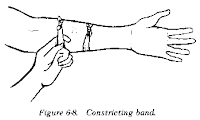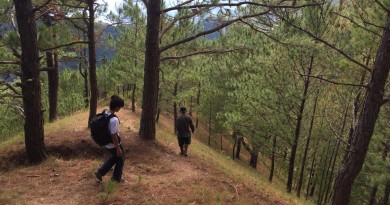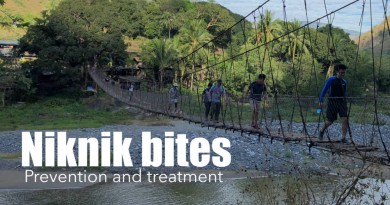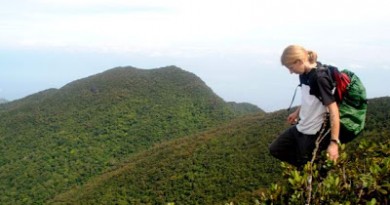Snake bites in the outdoors: prevention and first aid
 This is an article belonging to the ‘climb health‘ category in PinoyMountaineer. Information provided in this article are based on research and are not meant as a substitute to actual medical advice and healthcare.
This is an article belonging to the ‘climb health‘ category in PinoyMountaineer. Information provided in this article are based on research and are not meant as a substitute to actual medical advice and healthcare.
 Alongside with such nonsense questions like “How do you unload your stomach when you’re up there?” and “Why climb, you’ll just get tired?!”, a favorite question of nonhikers is, “Aren’t there snakes? What if you get bitten by a snake?”
Alongside with such nonsense questions like “How do you unload your stomach when you’re up there?” and “Why climb, you’ll just get tired?!”, a favorite question of nonhikers is, “Aren’t there snakes? What if you get bitten by a snake?”
There is a need to address this question, because most climbers actually don’t know what to do! The reason is, most climbers actually don’t get to experience seeing up close, let alone being bitten by a snake. There is a Tagalog saying, “Mas takot ang ahas sa tao, kaysa tao sa ahas.” – A snake is more afraid of men, than the other way around. This statement echoes human experience worldwide. But sometimes, instead of escaping, they turn defensive, and aggressive.
 And there are indeed many snakes in the Philippines. Out of a few hundred species, there are 30 poisonous snakes in the archipelago. Most of them stay in rural areas, preying on small mammals such as rats and mice. Usually they prefer moist areas such as rivers, being cold-blooded animals.
And there are indeed many snakes in the Philippines. Out of a few hundred species, there are 30 poisonous snakes in the archipelago. Most of them stay in rural areas, preying on small mammals such as rats and mice. Usually they prefer moist areas such as rivers, being cold-blooded animals.
So what do you do when you’re bitten by a snake? What do you do if someone in your climbing team is bitten by one? And is there a way to prevent yourself from bitten by one?
PREVENTION
Many folk would swear on the efficacy on garlic as a snake repellant. This is not without basis; the aroma of garlic is said to put away snakes. In fact Chinese medicine names garlic as an antidote for snake poison. But more reassuring than garlic would be physical measures to prevent snake bites. These include avoiding, as much as possible, night trekking in areas where snakes are known to be a menace. Snakes are active between dusk and dawn. Also, take the clearest, most open path on any trail, avoiding any loose rocks, bushes, etc.
SYMPTOMS AND FIRST AID
The principles of snake bite first aid is a mixture of common sense and logic.
The first step is to ‘diagnose’ a snake bite. Is it really a snake bite? Of course if you actually saw the snake bite the victim, you can proceed with the next step. Otherwise, look for the telltale bite marks of two fangs. A snake bite would moderate to severe pain on the site, together with swelling. There could likewise be skin discoloration (a sign of venom) and twitching skin at the site of the bite. Looking at the whole body, there could be symptoms such as nausea and vomiting, dizziness, sweating, slurred speech, mental status changes, among others. If you — or your teammate – is experiencing such — then proceed to the next step.
Immediately call for emergency help.
 Then, keep the victim calm and still. Immobilize him as much as you can. Don’t let him walk and if possible put a splint on the area of the bite. Place the bite below the victim’s heart level. Place a bandage or any constricting band – 2-4 inches above the bite and, if possible, another below it. But do not do so too tightly. All these will have the effect of preventing venom from getting into bloodstream and lymphatic system.
Then, keep the victim calm and still. Immobilize him as much as you can. Don’t let him walk and if possible put a splint on the area of the bite. Place the bite below the victim’s heart level. Place a bandage or any constricting band – 2-4 inches above the bite and, if possible, another below it. But do not do so too tightly. All these will have the effect of preventing venom from getting into bloodstream and lymphatic system.
If possible, try to identify the snake (note the color, size, pattern, etc.)
Clean the wound with soap and water.
Bring the patient to the nearest hospital. Continue monitoring him for any danger signs and symptoms. Perform CPR if warranted.
Throughout the ordeal, the important thing is not to panic – this goes for the victim and his teammates. There is also a great need to monitor the victim always for changes in the wound site and the victim as a whole.
WHAT NOT TO DO
DO NOT attempt to cut open the bite nor suck out the venom. If the venom should seep through any damaged or lacerated tissues in your mouth, you could immediately lose consciousness or even die.
Do not apply any ointment to the patient, or give him alcohol to drink. Simple soap and water ought to be used in cleaning the wound.
MEDICAL MANAGEMENT
In most of the cases, venom isn’t actually injected by the snake into the bite, and more commonly, the snake is nonpoisonous to begin with. Still, snakes may carry tetanus and thus hospital management is still required to administer tetanus vaccine and treat the wound.
If the snake proves to be poisonous and if venom is clincally proven to have been injected with the bite, then ideally, antivenom is administered immediately at the nearest hospital. However, in the Philippines it is not routine for hospitals to have antivenom. Still, first aid can be lifesaving especially if it can buy time for the victim to be brought to a specialized center that can deal with snake bites. Right now in Metro Manila two such centers are avaialable:
Research Institute for Tropical Medicine
DOH Compound, Filinvest Corporate City
Alabang, Muntinlupa
San Lazaro Hospital
Quiricada St., Sta. Cruz, Mania
(02)7323776
When climbing in ethnic territories with tribal or even local guides, you might be offered traditional medicines / herbs for snake bites. PinoyMountaineer does not have enough information to recommend or reject such, and they may be dealt with on a case-to-case basis. If the nearest hospital is really too far, then such alternative therapies may be an option. But even so, insist on doing all the first aid measures listed above. Local herbs may have antivenom properties that local healers understand.
CONCLUSION
While climbing mountains, the chance of getting bitten by a snake is very small. However, there are precautions that can be done to further lessen the chance, and if a snake bite still happens, there are principles of first aid that if carried out, can greatly reduce the risks of mortality and morbidity associated with snake envenomation. Understanding these statistics and principles can help allay fears of hikers and their loved ones.
TRIVIA
When you see a dead snake, handle it with care just the same! Dead snakes still have venom, and they can still actually inflict fatal bites by reflex action even after death!
The blogger is currently a fourth year medical student at the University of the Philippines – Philippine General Hospital under the INTARMED program.






Leave a Reply
16 Comments on "Snake bites in the outdoors: prevention and first aid"
all snake bites naman po is 'dry bite" yun yung kadalasan attack ng mga snakes pag nagiging agresibo sila. its just like tinataboy lang yung threat sa kanila pero pag once na ang isang ahas ay stress or nagulat., my chance na magenject ng venom. just to share nadin po. you can identify venomous snakes through their head. pag heart shape or triangulated, viper po yan which means yan yung mahahabang pangil na ahas, isa pa po yung sa mata if yung mata is like sa pusa (term namin dun is cat-eyed) most of them ay nocturnal at resembles a midly venomous snakes. 🙂 -Marvz Residence Biologist of Catanduanes (SILANG mountaineer)
Hi Sir Gid, I just want to share regarding dun sa request ni Sir cecil. kasu panu ko po ba ipopost dito yung study namin about 3 types of snakes we have here in the phils. (non venomous, mildly venomous and venomous) my mga pictures din po ako on how to identify those 3 types of snakes. 🙂 actually. recent study namin yun yung sa snake inventory na gusto ko sana ibahagi dito para makatulong 🙂 -Marvz Residence Biologist of Catanduanes SILANG mountaineer.
facebook,,,,,,jsclimbingholds
hai sa lahat sino po nimyo gustong bumili ng climbing holds mula sa pinas genawa at bago pa marami,,,,at muara lang sa tamang halaga…salamat po,,,,
Thank you for the snake information. I was thinking of killing one but changed my mind.